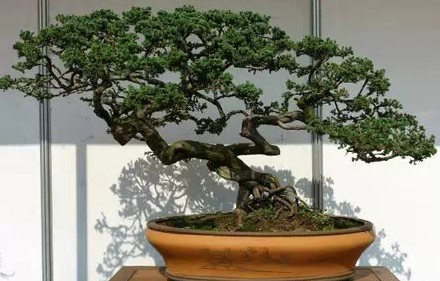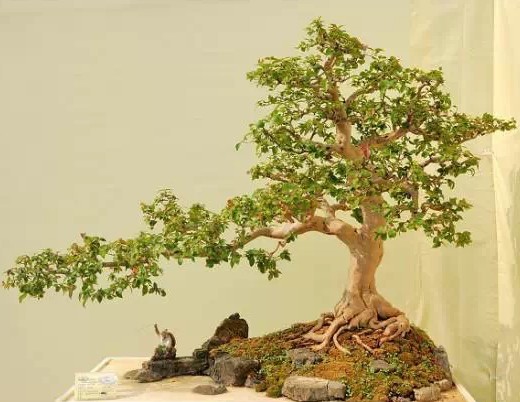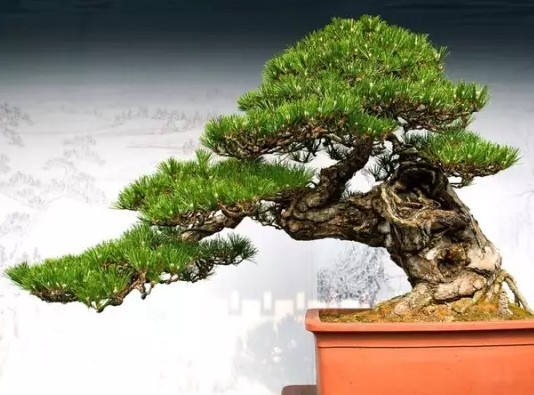The technical features and artistic style of Lingnan bonsai
Lingnan bonsai is mainly composed of tree stumps, which was produced in the 1930s and 1940s. Lingnan is located in the subtropics, with abundant rainfall and spring all the year round, which is suitable for plant growth. In history, Guangzhou is an early open trade port with an open mind and an inclusive culture. Due to the timeless geography, human history and other reasons, Lingnan bonsai has formed an artistic style with both Chinese tradition and the characteristics of Lingnan fresh and lively era. Lingnan bonsai and other schools of bonsai in the connotation and pursuit of goals are consistent, are the pursuit of poetic painting, both form and spirit; artistic techniques are derived from nature and higher than nature; modeling and branch techniques are to learn from the strokes and theories of traditional Chinese painting. However, in terms of forms of expression and production techniques, Lingnan bonsai is significantly different from other schools, thus forming a completely different artistic style.

Specifically, the technical features and artistic style of Lingnan bonsai are mainly shown in the following aspects:
1. Near-tree modeling, pay attention to details
If we say that other schools of bonsai pay attention to distant tree modeling, from a broad point of view, the performance of simple and dignified, then Lingnan bonsai is mainly near-tree modeling, pay attention to details, the performance of wild and natural, show the outside and the inside. This kind of near-tree shape is mainly reflected in the meticulous carving of the branches. Lingnan bonsai has a variety of branches, including deer horn branch, chicken claw branch, crab claw branch, falling branch, drooping branch, wind branch, natural branch, turning branch, windmill branch, spiral branch and so on. Different branch methods are used according to different shapes and themes to achieve different effects.
2. It is natural to store branches and cut them dry.
In terms of production techniques, bonsai in other schools are mainly tied up, while Lingnan bonsai is mainly cut, that is, branch storage is the main production technique. This is the main factor that forms the unique style of Lingnan bonsai. The so-called storage and truncation means that according to the needs of the tree embryo and shape, the trunk is cut, the branches are preserved and truncated, and the new branches are germinated at the top, and then cut when they grow to the right size, so repeatedly, the trunk is dwarfed and supple, the branches zigzag and powerful, as strong as iron. This unique technique makes Lingnan bonsai made by people, just like Tiankai, vigorous and vigorous, wild and natural, which is the embodiment of Lingnan bonsai's profound skills.
3. The law is ten thousand in shape and changeable in form.
Under the artistic rule of learning from nature and higher than nature, Lingnan bonsai widely collects the strange trees of nature, old trees and new branches, and does not stick to one style, does not stick to conventions, and its styles are varied. After decades of exploration and accumulation, we have created single-dry type, double-dry type, multi-dry type, cliff type, water shadow type, stone-attached type, horizontal basin type, flood and drought landscape type, jungle type, and straight tree type, big tree type, floating slope type, ancient banyan type, kapok type, ancient pine type and so on. It reflects the rich and varied forms of Lingnan bonsai.
4. Strict rules and regulations, beauty lies in coordination
The near-tree shape of Lingnan bonsai not only requires overall graceful coordination, but also has a set of strict rules for each component, such as root, stem, branch, tip and leaf. The root should be relaxed and the bend should be strong. Different tree types also have different requirements for roots, such as big tree type plate root, fluttering type partial root, kapok type plate root, cliff, water shadow type claw root, etc.; dry cloth node, rugged body, natural knot; branch support is rough, four branches are distinguished, striving for concession, weight and order; before and after the tip, it is appropriate to taper, dense but not solid, sparse but not scattered; leaves are expensive and small, dense and dense, not hidden in front and back, and reflect each other. The whole context of the tree is the same, looking forward to conveying feelings. Also pay attention to the coordination and cooperation of trees, pots and several frames.
5. interest of the four seasons, dynamic fax
This is the most expressive highlight of Lingnan bonsai. It clearly shows the different scenes of the four seasons through the techniques of pruning and picking leaves. Spring sprouting, new red dots; summer rich, green cover such as clouds; autumn Jinfeng, yellow leaves falling; winter cold weather, bare branches. The four seasons are interesting, pleasing to the eye, touching the scene, fascinating. Through the creation of artistic conception, affectionate to the tree, support the tree to express ambition, so that the scene in the basin, and God overflow outside the basin. It embodies the combination of form and spirit of Lingnan bonsai and the unity of formal beauty and connotation beauty.
Time: 2019-06-04 Click:
- Prev

Bonsai Art of Lingnan Culture
When it comes to Lingnan culture, people naturally think of Guangdong music, Cantonese opera, Cantonese cuisine, Lingnan painting school, Lingnan architecture, and talk about Lingnan folk art. They only talk about color, embroidery, tooth carving, jade carving, and so on, but seldom mention Lingnan bonsai. These are undoubtedly the quintessence of Lingnan culture or Lingnan folk art.
- Next

How far can contemporary Lingnan bonsai go
Modern modeling bonsai, also known as contemporary bonsai, is not new in the industry. Contemporary bonsai has become a rapidly developing force with huge market investment potential. Speaking of bonsai, many young friends will feel that bonsai modeling is inseparable from the traditional impression of miniature landscapes and miniature trees.
Related
- Fuxing push coffee new agricultural production and marketing class: lack of small-scale processing plants
- Jujube rice field leisure farm deep ploughing Yilan for five years to create a space for organic food and play
- Nongyu Farm-A trial of organic papaya for brave women with advanced technology
- Four points for attention in the prevention and control of diseases and insect pests of edible fungi
- How to add nutrient solution to Edible Fungi
- Is there any good way to control edible fungus mites?
- Open Inoculation Technology of Edible Fungi
- Is there any clever way to use fertilizer for edible fungus in winter?
- What agents are used to kill the pathogens of edible fungi in the mushroom shed?
- Rapid drying of Edible Fungi

